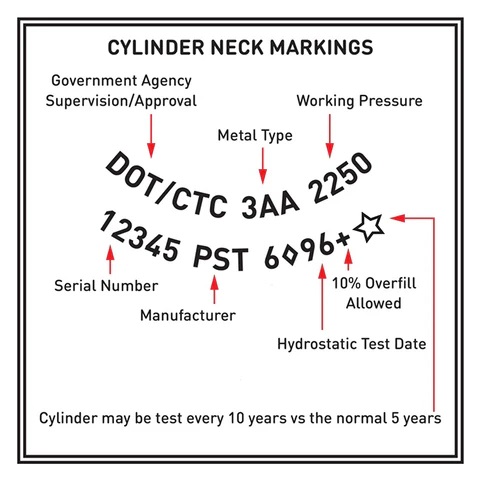Understanding Hydrostatic Testing
What is a Hydrostatic Testing?
Hydrostastic Testing or Hydro-Testing is a process in which a cylinder is externally and internally inspected to confirm the cylinder is safe to fill and be transported.
How do I know if my tank needs to be hydro-tested?
You can identify the last time your cylinder was hydro-tested based off the markings stamped into the crown (top) of the cylinder. Use the diagram below to reference the last Hydrostatic Test Date.


How often do I need to have my tanks hydro-tested?
Referencing the Metal Type on the diagram above, identify the Metal Type code on the crown of your cylinder. Match that code to the code below and that will inform you how often your tank needs to by hyrdo-tested.
DOT-3AL gas cylinders must be tested every 5 years and have an unlimited life.
DOT-3HT gas cylinders must be tested every 3 years and have a 24-year life.
SP-Cylinders Special Permit
DOT-3AA gas cylinders must be tested every 5 years and have an unlimited life. (Unless stamped with a star (*) in which case the cylinder meets certain specifications and can have a 10-year hydrostatic test life)
If the tank requires a hydro-test you can purchase it on LABalloons.com, then bring your cylinder in to our Glendale, CA location. Please allow for 2-3 weeks for the hydro test to be completed.
Hydrostatic Testing (Requalification) – The Process
A brief description of the requalification process follows. The cylinder has its valve removed and all external and internal surfaces made visible to the DOT (Department of Transportation) qualified hydrostatic tester. The cylinder is externally and internally visually inspected according to required DOT specifications. If it passes, the hydrostatic test is performed.
To hydrostatically test the cylinder, it is placed inside of a water jacket (containing water) which is sealed with hydraulic clamps. The cylinder is filled with water. The cylinder is then pressurized with even more water via a high-pressure pump. The cylinder expands a little and displaces water in the water jacket. The amount of water displaced in the water jacket is measured by a precision method. This amount of water displaced signifies how much the cylinder expanded under pressure. When the water pressure returns to normal, the amount of expansion that still exists (the water not taken back into the water jacket) is called the permanent expansion. This information is recorded and compared to DOT requirements to determine if the two expansions of the cylinder adhere to DOT regulations.
If the cylinder passes the internal and external inspection and retest, the retester marks the all-metal cylinder by stamping into the metal or labels a composite cylinder with a label sealed in resin. The information marked or labeled includes the RIN identification and the retest date. A record is then made of the requalification with the information mandated by the DOT.
The retester is required to stamp out cylinder DOT markings with X’s or with the word “Condemned” if the cylinder does not pass the hydrostatic testing process. Cylinders that are fully wrapped with composite materials that do not pass requalification are labeled condemned. The cylinder should be rendered unable to hold pressure with the permission of the cylinder owner. It is recommended that all cylinder owners permit the hydrostatic testing facility to render condemned cylinders unable to hold pressure by drilling through the cylinder or terminating valve threads. A record is made of condemned cylinders, according to DOT standards.
Čak i nakon nekoliko pokušaja analnog seksa, mnoge djevojke još uvijek vjeruju da je to strašno mučenje koje herojske žene idu isključivo https://farmacija-hrvatska.com/viagra-genericka-bez-recepta-online/ njihovog partnera. Informacije o vašem zadovoljstvu, opuštanju i svim orgazmima govora ne mogu biti. A od muškaraca često osjećamo da žene koje vole analni seks postoje. I ne, to nije bajka, ni jednorog, pa čak ni heroina porno filmova.